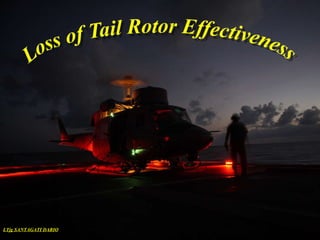
Loss of Tail Rotor Effectiveness -English-
- 3. Event An uncommanded right yaw rate that does not subside of its own accord and, which, if not corrected, can result in the loss of helicopter control.
- 4. Loss of Tail Rotor Effectiveness This uncommanded yaw rate is referred to as loss of tail rotor effectiveness (LTE) and occurs to the right in helicopters with a counter- clockwise rotating main rotor and to the left in helicopters with a clockwise main rotor rotation.
- 5. Loss of Tail Rotor Effectiveness LTE is not related to an equipment or maintenance malfunction and may occur in all single-rotor helicopters at airspeeds less than 30 knots. It is the result of the tail rotor not providing adequate thrust to maintain directional control, and is usually caused by either certain wind azimuths (directions) while hovering, or by an insufficient tail rotor thrust for a given power setting at higher altitudes.
- 10. WEATHERCOCK STABILITY (120-240°) In this region, the helicopter attempts to weathervane its nose into the relative wind. Unless a resisting pedal input is made, the helicopter starts a slow, uncommanded turn either to the right or left depending upon the wind direction. If the pilot allows a right yaw rate to develop and the tail of the helicopter moves into this region, the yaw rate can accelerate rapidly. In order to avoid the onset of LTE in this downwind condition, it is imperative to maintain posi- tive control of the yaw rate and devote full attention to flying the helicopter .
- 11. TAIL ROTOR VORTEX RING STATE (210-330°) Winds within this region will cause the tip vortices generated by the tail rotor blades to be recirculated through the rotor, in the same way that main rotors re-ingest wake vortices in an improperly executed descent. The resultant VRS of the tail rotor causes tail rotor thrust variations that result in unsteady yaw forces. If a right yaw rate is allowed to build, the helicopter can rotate into the wind azimuth region where weathercock stability will then accelerate the right turn rate. Pilot workload during VRS will be high, therefore, the pilot must concentrate fully on flying the aircraft and not allow a right yaw rate to build.
- 12. Main Rotor Disc Vortex Interference (285 - 315 degrees) Winds within this region can cause the main rotor vortex to be directed onto the tail rotor. The effect of this main rotor disc vortex is to change the tail rotor AOA. Initially, as the tail rotor comes into the area of the main rotor disc vortex during a right turn, the AOA of the tail rotor is increased. This increase in AOA requires the pilot to add right pedal (reduce thrust) to maintain the same rate of turn. As the main rotor vortex passes the tail rotor, the tail rotor AOA is reduced.
- 13. Main Rotor Disc Vortex Interference (285 - 315 degrees) The reduction in AOA causes a reduction in thrust and a right yaw acceleration begins. This acceleration can be surprising, since the pilot was previously adding right pedal to maintain the right turn rate. Analysis of flight test data during this time verifies that the tail rotor does not stall but the helicopter will exhibit a tendency to make a sudden, uncommanded right yaw.
